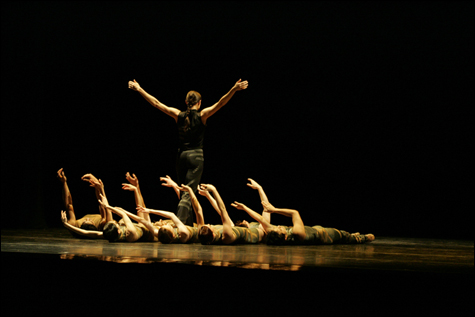Learning to soarFestival Ballet’s masterful Motion February 5,
2008 5:29:09 PM

IN DREAMS: A scene from Viktor Plotnikov’s Coma.
|
Ballet has come a long way from its initial image of tights, tutus, and toe shoes. Not that Festival Ballet Providence doesn’t feature all of those in one of the three dances they willl perform for Masters of Motion at the VMA Arts & Cultural Center (February 8-10).
British choreographer Antony Tudor’s The Leaves Are Fading does have the three “t’s” for its dancers, plus a very classical look to much of its movement. But Agnes de Mille’s Rodeo overlays a Western cowboy theme onto a ballet, with appropriate costumes, poses, and gestures. And Viktor Plotnikov’s Coma, which premiered to great acclaim last spring, introduces an almost abstract element, as dancers portray comatose people and their loved ones.
De Mille’s high-energy, knee-slapping romance, set to the spirited music of Aaron Copland, was created in 1942 for the Ballet Russe de Monte Carlo. With a lively backdrop of hoedowns, cattle-roping, and horseback riding, plus a tomboy played by de Mille herself, Rodeo was such a hit that she was chosen to create the dream ballet for Rodgers and Hammerstein’s Oklahoma. The realistic cowboy/ cowgirl mannerisms that de Mille imposed on ballet moves gave Rodeo an almost cinematic quality (her uncle was Cecil B. de Mille), as well as a humor and vitality that have made it a keeper.
When the curtains opened last April on Plotnikov’s Coma, there was a collective gasp from the audience at the indelibly evocative image of prone bodies suspended on slowly swinging platforms, their legs and arms hanging limply. Inspired by the ’78 film Coma, Plotnikov has said that he wanted to give audiences his vision of comatose individuals and those who keep a vigil at their bedsides, in three sections titled “Our Dreams,” “Reality,” and “Their Dreams.” It is set to the transfixing music of Arvo Pärt.
The legacy of a master choreographer’s ballets are often held in trust, with certain individuals designated to teach them to ballet companies. Thus, Paul Sutherland, whose first performance at the American Ballet Theatre in 1957 was Rodeo, came to Providence to set the ballet on Festival dancers. And former ABT principals John Gardner and Amanda McKerrow, who danced under Tudor and who performed the main pas de deux from Leaves in the late ’90s, spent two residencies in Providence, imparting the wisdom of not just how to move through the dance but how to give this ballet the spirit that makes it soar.
For soar it must, with four major pas de deux, in which female dancers are sometimes carried overhead across the stage or lifted in quick succession as they move around a circle. The most startling (and impressive) lift comes when the female dancer is perched on her knees on the bent knees of her partner, and he lifts her gently from that position to over his head. When I saw this move in ABT’s presentation of Leaves at NYC’s City Center last fall (which Gardner and McKerrow also staged), I was amazed at the strength and delicacy of the dancers.
In rehearsal with the Festival dancers in early January, McKerrow repeatedly advised them: “There are so many people doing complicated partnering — the danger of this ballet is you can be caught unaware. You have to work as a group.” And Gardner added: “Men: you’re a focal point. The carriage you bring to the dance really matters. Keep your feet happy; don’t let them get sad and slow down.”
The latter may have applied to a folk dance section in which the men leap in a circle, fists clenched. But much of the movement has a romantic flavor to it, a longing in the tilt of a head, a flirtation in the sweep of a hand, a playfulness when a male dancer holding a female dancer by her wrists swings her marionette-like in front of him.
During a break in the rehearsal, Gardner noted that the ballet, set to music by Antonin Dvorak, is loosely based on the theme of love, the phases of relationships, and of a life that a woman is thinking back upon.
“Tudor was a Zen Buddhist at this point in his life,” Gardner noted, “and he may be have been at a more reflective place.”
The Leaves Are Fading will put you in that place, too.
|
 |

|
- Reconciling the irreconcilable
- Massachusetts lawmakers are pushing to criminalize Salvia. Is this a test-run for marijuana-law reform?
- Some Things at Trinity
- College gossip blogs exposed
- Never mind its tough-girl alt-porn feminism: SuicideGirls has already moved on to a new generation
- In honor of National Boss Day, thePhoenix.com presents the ultimate kingpins
- Daniel McCusker’s ‘tHisTHat’
- How did Deval Patrick's greatest strength become a dangerous weakness?
- The democratic race is getting messy, which can only mean one thing: it’s time to recruit Al Gore
- 50 years after the Boston Braves' departure, it’s worth asking: did the wrong team leave town?
- Artful lodger comes to MIT
- Nightlife
|
-
Hospitality from south of the border
-
Sara Gruen’s fictional menagerie
-
Festival Ballet’s emotional Swan Lake
-
A place that succeeds by design
-
The Italians, French, and Greeks are on to something
-
In House Freestyle connects on many levels
-
Fusionworks’ captivating mood swings
-
Festival Ballet’s intimate showcase
-
Still swinging
-
Mixed Magic’s latestSpirit Warrior
|

- Daniel McCusker’s ‘tHisTHat’
- Festival Ballet’s emotional Swan Lake
- Lorraine Chapman, Kinodance, Black Grace
- The Russian National Ballet’s Beauty
- The Kirov at City Center, plus Jerome Robbins, Stephen Petronio, and Cloud Gate
- Ohad Naharin’s Minus One
- Liz Lerman and Sayat Nova
- Fusionworks’ captivating mood swings
- Speaking with the New England Dance Project
- Daniel McCusker at Tufts, Kelley Donovan at the Dance Complex
|
|